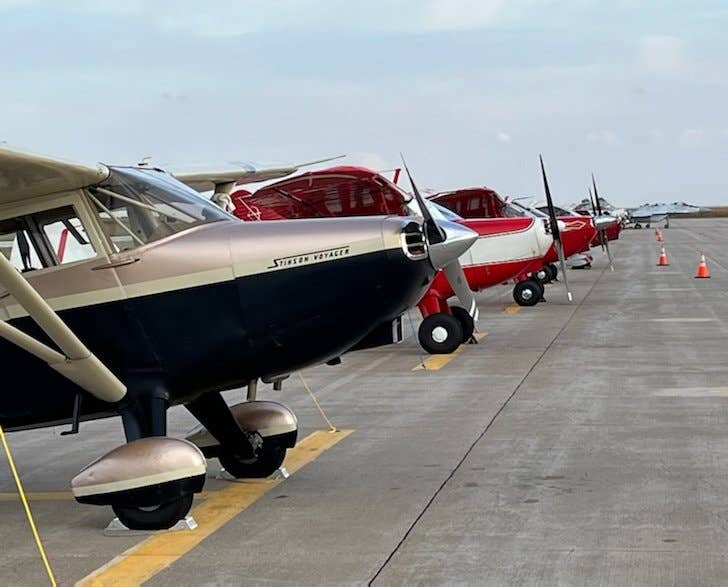Pilots Gather at the 2022 Stinson Summit
Pilots gathered in Quincy, Illinois, at the 2022 Stinson Summit for seminars on maintenance, Stinson history, and some collegial gathering.

Stinsons grace the runway at the Stinson Summit in Quincy, Illinois (KUIN). [Credit: Jason Blair]
There is great value in tribal knowledge when it comes to keeping our historic airplanes flying. Sharing that tribal knowledge requires bringing together the members of the tribe to share. It has become a lot easier to do this online now, but it just isn’t the same as bringing together people who operate and maintain 70- to 80-year-old airplanes like Stinsons in person. This is exactly what happened this past weekend at the Stinson Summit in Quincy, Illinois (KUIN). Stinson owners, mechanics, and pilots gathered in Quincy for seminars on maintenance, Stinson history, and some collegial gathering.
An aircraft with a long production history starting in Michigan, the multiple Stinson models have seen a wide variety of modifications over the years. Type clubs such as this serve as custodians of information about unique and antique aircraft and are one of the most important methods of sharing best practices for owner maintenance, information about upgrades, STCs, potential maintenance concerns, and piloting techniques.
“We are pleased to again bring together the members of the Stinson family,” said Brett Chilcott, owner of a 1947 Stinson 108-2. “Every time we do this we al get the benefits of camaraderie and information exchange. It makes us all more effective at keeping these pieces of aviation history alive and functioning in our general aviation community.”
Passing Along Resources and Knowledge to the Next Generation
While not every Stinson owner makes it to such an event, those that do learn and then go back to their home aviation communities and share resources with others. For an aircraft that last saw updates to maintenance manuals and even engine maintenance manuals, especially for those that are still operating Franklin engines, decades ago, these events keep knowledge from dying with the older generation of pilots. The last generation of Stinson operators shares their knowledge with the current generation, and the current generation has a duty to share information with the next generation. This is how we keep historic aircraft flying for another generation.
Many of the Stinsons present represent a unique merging of antique and modern. Some had older Franklin engines; some were modified to newer, more current engines with more horsepower. Some had classic VFR-only panels; some were upgraded to modern avionics that were as capable as most modern new production glass panel aircraft. A historic, classic airframe, the Stinson has proven to be adaptable and still relevant to flying in the modern aviation system. This is something that many antique aircraft have been unable to do. Stinsons have proven to be classic and adaptable for modern owners who still love flying them.
I include myself in that group. This event marked a five-year anniversary for my wife and me in the ownership of a 1947 Stinson 108-1. I fly the aircraft regularly to and from the practical tests I give as an FAA designated pilot examiner (DPE), but we also fly it for fun, and I still get a little cranky when it has been too long between flights. My wife will confirm this.
If you are a Stinson owner or operator, join the International Stinson Club. If you don’t own a Stinson, but have another classic aircraft for which there is a type club, join it. I promise your membership will pay dividends in knowledge about your aircraft and help support the communities that keep these pieces of aviation history flying.

Subscribe to Our Newsletter
Get the latest FLYING stories delivered directly to your inbox






